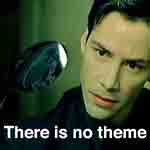Once again, I have had conversations with clergy trying to find a theme in the readings and psalm of the Three-Year Sunday Lectionary. So, in the manner of Throwback Thursday and in some ways continuing from a couple of days ago, I say again: There is no theme.
I regularly find this misunderstanding. There is nothing in the lectionary booklet itself to help. In its explanation, “Understanding the Lectionary”, it merely states, “For the Sundays after Trinity Sunday two alternatives are provided: Continuous and Related. Choose one of these options and remain with it throughout the period. It is unhelpful to move from week to week from one column to another.” (page 6).
On Sundays, we have been reading systematically through the letter of St Paul’s Second Letter to the Corinthians since we started back in Ordinary Time after the Easter Season. This is the second reading, following the Psalm, Sunday by Sunday. The Gospel reading is systematically working through St Mark’s Gospel. So if there is any connection, any “theme” between these two readings, it is purely coincidental.
It is not the fault of the clergy here – liturgical study, training, and formation continues to be at a low point here, something that continues to amaze me, considering that leading worship is a primary role of the ordained.
NZ, in the first flush of liturgical renewal in the 1960s, developed a thematic Sunday lectionary. It chose a list of themes, Sunday by Sunday, and then, concordance-like, chose readings to fit with those themes. Soon tiring of this cycle, it chose a second set of readings, concordance-like, making a two-year “thematic” lectionary. Obviously, readings were repeated, important ones omitted, and some preachers discovered that the reading had nothing really to do with the “theme”, but were actually more about something else entirely. But this Two Year “thematic” Sunday lectionary (still dominating much of A New Zealand Prayer Book He Karakia Mihinare o Aotearoa) set up a “theme culture” which is still being passed on from training vicar to curate and in the minds of many congregants, members, and communities.
The Church of England (in the Alternative Service Book) approached things slightly differently. They produced a list of important readings, and then tried to cluster readings together sort-of-thematically.
In Celebrating Eucharist I wrote:
Themes
The Eucharist is a thanksgiving for creation and redemption. That is the primary theme and anything “more” is icing on the cake. Human celebrations are normally of events rather than abstract concepts. Similarly, the scriptures tell the story of a God who acts (action again) and through our remembering and thanksgiving we are renewed to act in response. A theme may be one attempt to summarise briefly a message in the readings within the context of this present gathering. Preoccupation with finding a theme for each service, however, may limit the impact of a service. Community worship is like a lake upon which liturgy can cast a number of stones, each sending out its pattern of ripples. One person (a new Christian) may connect with the opening hymn, another (a person who has worshipped since her youth) with the Collect, another (just unemployed) with the first reading, another (coming to church for the first time since her husband died) with the Psalm, and so on.
Often the feast or liturgical season provides “theme” enough. Advent prepares for Christ’s coming. Christmas celebrates Christ’s birth. Like a particular type of restaurant (Mexican, Chinese, Indian,…), such a “theme” provides the mood in which the meal is enjoyed rather than a straightjacket for the service.
It is often said that people gave a sigh of relief at the abandonment of the ASB two-year Sunday lectionary and its artificial themes. The Church of England has gone further, and in Common Worship the collect is not tied to the readings. New Zealanders, on the contrary, regularly continue to search for a theme even when there is no theme! A “thematic” collect is now provided in our lectionary booklet. Some even try to force the three year readings into an unfitting straight-jacket by announcing the Sunday’s theme from the Two Year thematic cycle (so that, for example, next Sunday, being the Sixth Sunday after Pentecost, has the theme of “God’s Purpose” NZPB p612)!
So, read my lips: there is no theme! Read the readings set for the Sunday, pray about them, read commentaries about them, discuss them – and then preach about what the Spirit is saying to the Church through them.
If you appreciated this post, do remember to like the liturgy facebook page, use the RSS feed, and sign up for a not-very-often email, …





Of course, in the BCP, the collect and readings for Sundays are set, although, rarely used sthese days.
We do BCP regularly, but use the CW lectionary readings and collects as a norm.
Thanks, Ernie. There’s still a lot of BCP around in NZ (probably 1928ised). It would be interesting to know what readings and collects are used here – more research for someone. Blessings.
I’m intrigued you mention a lot of BCP being around. Is that the hangover of the compromises that made liturgical renewal possible, or is something else going on there?
It almost seems like something approaching an ideal answer to your Church Of Or series…
Thanks, Kieran. What a fascinating reflection. That sounds like a great study: why is BCP (1662/1928) still around and is this evidence of yearning for common prayer. Blessings.